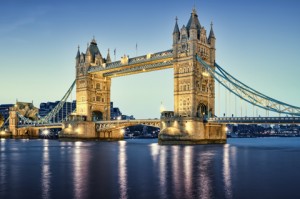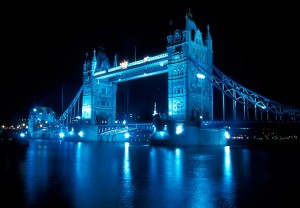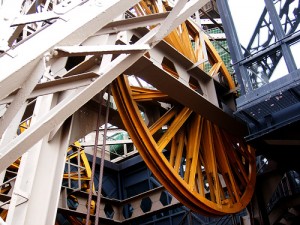How Tower Bridge Works
Discover how London’s distinctive landmark uses suspension and bascule technology to bridge the River Thames.
Work began on this extraordinary bridge in April 1886 and was planned to be completed by 1889. Five years later than originally estimated, the bridge finally opened on 30 June 1894, a cost of GBP 1 million (approximately GBP 100 million by today’s standards). Many of the delays were caused by the requirement for the bridge to fit in with its surroundings and the sheer scale of the enterprise.
The Tower bridge had to meet the needs of road traffic that wanted to cross the Thames and the demands of the river traffic. The solution was to construct a bascule bridge; this is from the French term for ‘see-saw’. The bascules consist of two equal length sections that can be raised or lowered like drawbridges, from 65-metre tall towers built on piers on either side of the river.
It was constructed with 14,000 tons of iron and steel girders and columns. To protect the steelwork and to echo the architecture of the nearby Tower of London, it was dressed with 35,000 cubic feet of Cornish granite and Portland stone, backed with brickwork. Altogether, 31 million bricks were used to build the bridge.
 The piers supporting the towers were the first and most complicated task for the 432-strong construction gang, as they contain the equipment to operate the bascules.
The piers supporting the towers were the first and most complicated task for the 432-strong construction gang, as they contain the equipment to operate the bascules.
They had to position caissons (wrought iron boxes with no top or bottom) seven metres below the riverbed, that were welded together to form a hollow column. 12 caissons were needed for each pier and when finished they were filled with concrete. This slow process took four years and used 70,000 tons of concrete.
On the landside approaches to the towers, suspension road bridges were built that were anchored to the pedestrian walkways that span the towers. Each of the 82-metre long side spans carry chains from the main towers to their respective abutment towers.
Navigation control
 Today, if you have a vessel with a nine-metre or higher mast or superstructure, you have to order a free bridge lift 24 hours in advance of your arrival. The bridge opens and closes approximately 1,000 times a year, and is operational every day of the year. VHF radio is used to keep shipping traffic in contact with the bridge control room, so that passing through the bridge is quick and efficient.
Today, if you have a vessel with a nine-metre or higher mast or superstructure, you have to order a free bridge lift 24 hours in advance of your arrival. The bridge opens and closes approximately 1,000 times a year, and is operational every day of the year. VHF radio is used to keep shipping traffic in contact with the bridge control room, so that passing through the bridge is quick and efficient.
In the past, the bridge displayed red semaphore signals on the piers to control daytime shipping. At night, the piers showed two red lights to indicate the bridge was closed and two green lights if it was open. A gong was used if visibility was reduced. Ships planning to go through the bridge had to hoist a 0.6m diameter black ball when travelling in daytime, or show two red lights at night.
The lifting mechanism
 The two sections of the bridge known as ‘bascules’ were originally lifted using two 360 horsepower steam-powered pumping engines. These engines pumped pressurised water to the accumulators, that stored it ready for use when the bridge bascules were needed to be lifted. Two of the accumulators were positioned in the accumulator tower and two were positioned inside each pier underneath the bridge towers.
The two sections of the bridge known as ‘bascules’ were originally lifted using two 360 horsepower steam-powered pumping engines. These engines pumped pressurised water to the accumulators, that stored it ready for use when the bridge bascules were needed to be lifted. Two of the accumulators were positioned in the accumulator tower and two were positioned inside each pier underneath the bridge towers.
The water power from the accumulators was sent to the driving engines that used hydraulics to lift the bascules. This complex mechanism enabled the bascules to reach an angle of 86 degrees in only one minute. Therefore, the whole process of opening and closing the bridge could take as little as five minutes.
Hydraulics are still used today, but the power now comes from electrical engines, and oil is used as the hydraulic fluid. The old accumulators, pumping engines and boilers can be viewed at the Tower Bridge Exhibition.

